
- Share via
SANTA CRUZ COUNTY, Ariz. — The border wall arches over the steep slopes of the Sonoran Desert, a vast row of brown steel slats jutting up from the rugged terrain, rippling with heat in the afternoon sun. A man dressed head to toe in camouflage and carrying an AR-style rifle huffs and puffs his way up one hill and scans the horizon.
Over the radio, his comrades in Arizona Border Recon, a civilian patrol group, report finding 31 migrants near a spot where the wall abruptly ends. The remote area west of Nogales, Ariz., called California Gulch, is where fencing built during the Trump era gives way to miles of open but unforgiving wilderness.
Half a dozen members of the ragtag patrol have set up camp nearby. Their 64-year-old leader, Tim Foley, says it’s a corridor for smuggling people and drugs, activity he and his group aim to disrupt.
“They got dumped down here by the cartel,” Foley says of the migrants. “They didn’t know where the hell they were at.”
The encounter at the wall reflects the extremes to which perceptions of border insecurity are now driving the actions of both citizens and the government. Fueled by right-wing rhetoric about the border being overrun, long-established groups such as Foley’s are enjoying a resurgence, attracting volunteers from across the country and influencing the national debate on immigration.

Apart from Foley’s group, anti-government militias active in Arizona and Texas have spread Q-Anon conspiracy theories and filmed themselves “intercepting” migrant children before delivering them to the U.S. Border Patrol, according to the Southern Poverty Law Center, a nonprofit advocacy organization.
One group has been documented crossing the border into Mexico on its patrols. At the same time, some Republicans in Congress have called for declaring drug cartels terrorist organizations and launching U.S. military strikes against them on Mexican territory.
Self-proclaimed Proud Boys have patrolled the border in southern Arizona since at least 2021 — often in coordination with established militias. Foley said he’d spoken several times with Oathkeepers leader Stewart Rhodes, who was sentenced to 18 years in prison on seditious conspiracy charges in connection with the Jan. 6 insurrection. Foley denied any formal relationship between their groups. He said he was in Washington when the Capitol was overrun but did not enter with the mob.
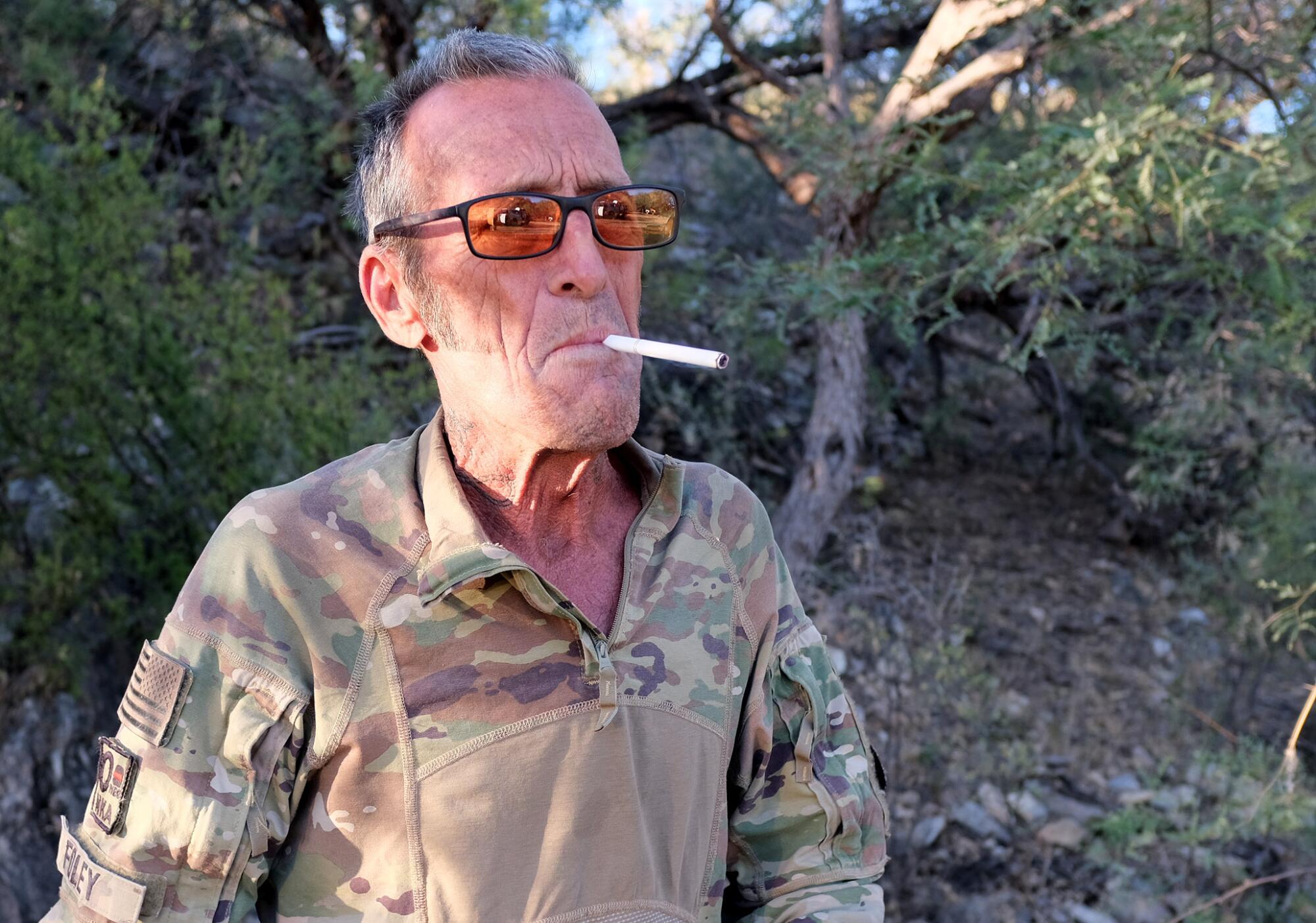
Arizona Border Recon keeps watch over the wall only for a few weeks at a time, covering a minuscule fraction of the nearly 2,000-mile frontier. But as the group’s charismatic frontman, Foley is often handed a microphone — once at a 2018 Capitol Hill news conference alongside top White House officials.
Foley is a chain smoker with Elvis sideburns and leathery tattoos poking from the sleeves of his military fatigues. He has a knack for speaking in sound bites and a love/hate relationship with the media. He welcomes journalists on his camera-friendly patrols. But he grumbles about what he perceives as left-wing bias against him and how the media presence gives away his location to the Sinaloa cartel scouts that he says are atop the hills on the other side of the wall.
Foley is flanked this day by several of his followers. Although they are all seemingly dressed for combat and carrying rifles, they are not affiliated with any law enforcement organization. They lack the authority to detain migrants — but they don’t let them pass either. They call the Border Patrol, then wait for agents to arrive in vans and collect them for processing.

The youngest of the 31 migrants is 5 years old. They say they’ve come from Ecuador, Honduras, Guatemala and El Salvador, some fleeing extortion and planning to seek asylum. An older man with a mustache who didn’t give his name said they were robbed and abandoned by their coyote three days earlier. They had been lost in the desert ever since, running out of food and water. They were wandering in search of cell service to call for help when Foley’s men spotted them.
“We would have brought them back [into our camp] and fed them,” Foley said. “Women and children, hey, I’m not going to let ‘em f—in’ die. If they were in camouflage clothing and they are all males, we would have pushed them back into Mexico.”
The country is indeed grappling with an unprecedented influx of asylum seekers, who mostly surrender at ports of entry, exercising their right to seek refuge from persecution in their home countries. Federal data show more than 2.4 million people were apprehended crossing the border in the 2022-23 fiscal year, an uptick from the previous year and the most since the government began keeping track in 1960.
But not all border locals are supportive of the militias’ cause. The lone bar in Arivaca, the 700-person town where Foley lives, has banned his group and others like it from entering the establishment, according to a sign prominently displayed on the door.

Nearby is the home where Raul and Brisenia Flores once lived. The father and his 9-year-old daughter were killed by members of a militia called Minutemen American Defense in 2009; for many Arivacans, these wounds have not healed.
David Sarando is a board member with Humane Borders, a volunteer group that maintains dozens of water stations in the desert south of Tucson. He said they have found their tanks knocked over, shot and stabbed. Members of his group have been harassed, he said, and other humanitarian workers have filmed aggressive behavior. Sarando fears violence if the militia activity remains unchecked.
“It’s not going to be too long before these guys get hot on their triggers, running around playing army and end up killing somebody,” he said. “I think that’s where it’s headed.”
Foley said he and his men follow the law, acting more like “a neighborhood watch” than vigilantes. His group provided water to the 31 migrants they found at the wall — by using water jugs left out by a humanitarian group.
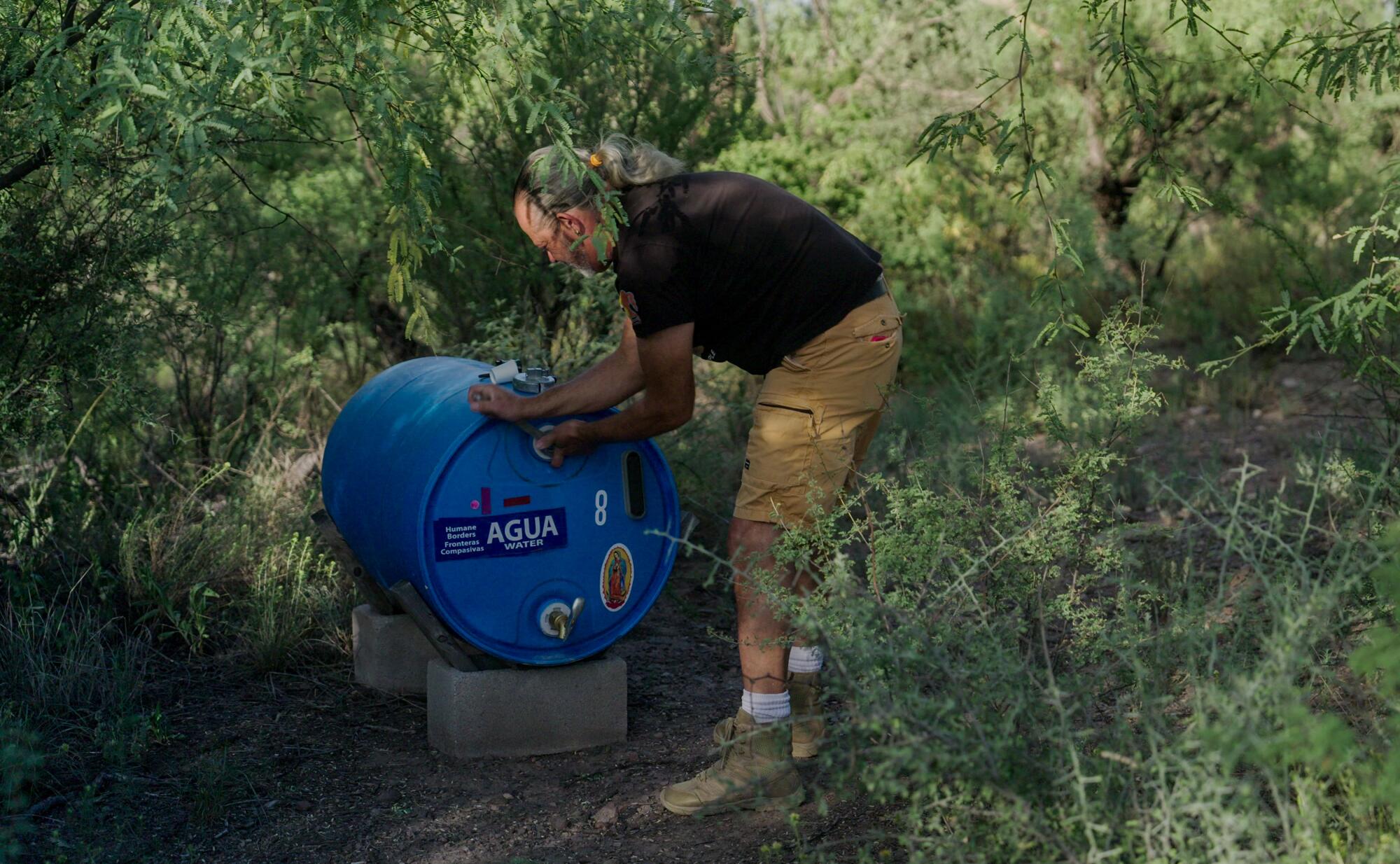
“Under the Constitution, if the government cannot protect you, you have the right to protect yourself, and that’s what we’re doing,” Foley said. “If getting off the couch and doing something is extreme, then, sure, we’re extremists. Sitting on the couch thinking everything’s rainbows and unicorns? That’s asinine.”
Some of his ideas about securing the border by any means necessary have taken root in mainstream politics. Former President Trump has promised that if he’s reelected he will withdraw thousands of U.S. troops stationed overseas and redeploy them to the southern border, along with reinstating policies to turn away asylum seekers.
Texas Gov. Greg Abbott has sent more than two dozen busloads of migrants to Los Angeles, and ordered a floating barrier and razor wire placed along the Rio Grande. Texas lawmakers passed legislation this year to allow local police to make arrests for illegal border crossings, a job currently reserved for federal authorities. Another bill proposed creating a civilian “border protection unit” and granting members some immunity from prosecution for deterring migrants.
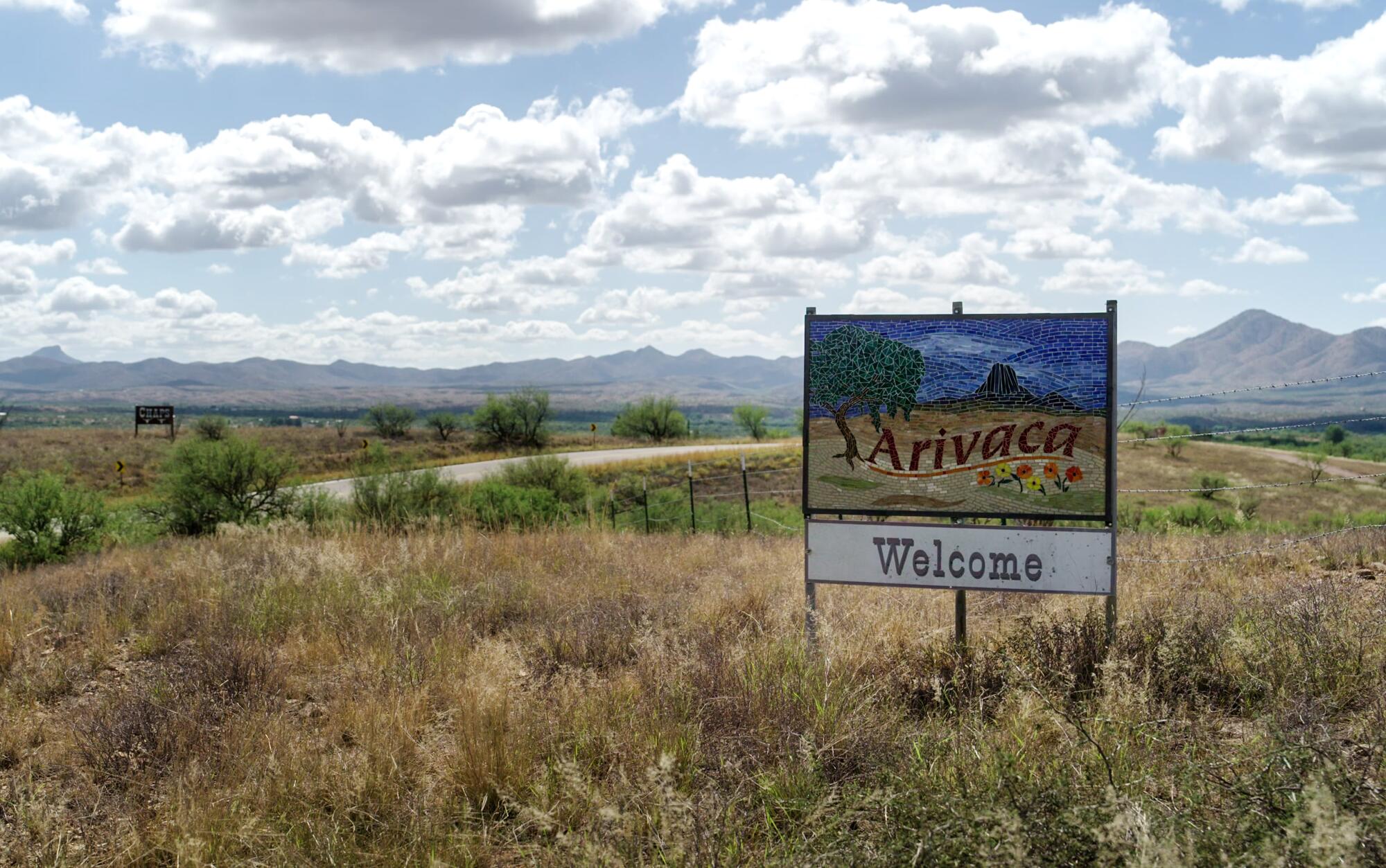
In Arizona, the previous governor erected a makeshift border wall made of more than 3,000 shipping containers, drawing a federal lawsuit that was dismissed after the state agreed to remove the containers and pay $2.1 million to repair environmental damage.
Pinal County Sheriff Mark Lamb, running as a Republican candidate for U.S. Senate in 2024, told The Times he believes citizen-led efforts to patrol the border are protected by the Constitution. Lamb said the presence of armed civilians in camo can be problematic for law enforcement because, “we don’t know who the good guys and the bad guys are oftentimes,” but he understands the sentiment.
“I think there are a lot of Americans, if they didn’t have to worry about making a living for their families, that you would probably see them lined up on the southern border,” Lamb said. “That is how angry they are. That is how furious they are with this administration and this open border policy to the point where they want to go pick up a gun and stand on the border to secure it because the government’s not doing it.”
***
- Share via
Criminal justice editor Keegan Hamilton talks about shadowing Arizona Border Recon, a militia group operating near the U.S.-Mexico border.
Alejandro Alvirde, a Border Patrol agent in the Nogales sector, told The Times that about 90% of the people he and other agents encounter are seeking asylum. The rest are trying to evade capture, either by climbing over the wall and making a break for it into the city, or trekking deep into the surrounding desert. The concertina wire atop some portions of the wall is littered with shreds of camouflage clothing left behind by migrants who became tangled on their way down.
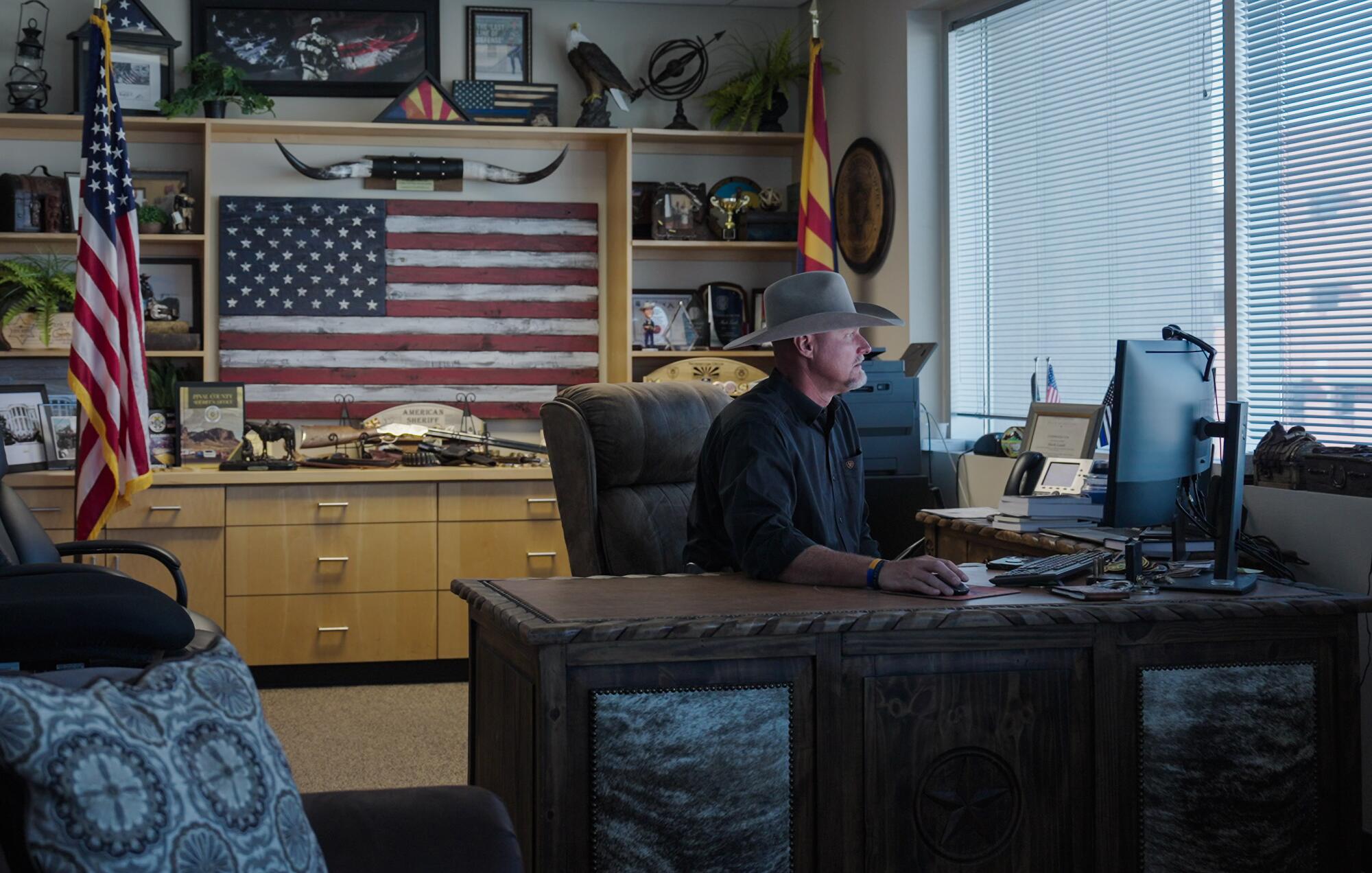
“They may have a criminal history, but most of the time, it’s just people who are just trying [to get] here for economic reasons, trying to enter the country,” Alvirde said.
As for Foley and others who take it upon themselves to conduct armed patrols, Alvirde said: “If any concerned citizen wants to call us and give us information, then we welcome that information. However, we do not actually want people to stop migrants, to actually take any type of enforcement action.”
The degree of real-world effect achieved by Arizona Border Recon and other groups varies widely depending on who is asked. Foley says rank-and-file Border Patrol officers sympathize with his cause and welcome his intel, but his achievements are difficult to quantify. One of his men claimed to have cracked the cartel’s radio encryption on the other side of the border. But he said only a couple of them speak fluent Spanish, and they can’t quite decipher the coded language the smugglers use to discuss movements.
Foley has set up a network of “trail cams,” hiding the motion-triggered cameras on suspected smuggling routes. The footage captures a lot of desert wildlife — foxes, skunks, deer and raccoon-like coatimundis — along with occasional single-file processions of people wearing camo, backpacks and carpet-soled slippers that are said to obscure footprints. He notes the time of the crossings and sends his men out for a few hours in an effort to temporarily shut down that route.

Foley was in the Army, and a few of his men have some relevant training and military experience, including one who said he was a paramedic. But most are white guys in their 40s and 50s with day jobs who spend a week of their free time camped out along the border taking orders from Foley as if he’s their commanding officer.
Foley’s supporting cast is less eager to seek out the spotlight. Members who spoke with The Times declined to share their last names, some citing concerns about how their professional lives would be affected. Hugo, 59, said he runs a car service in Connecticut and rarely discusses his border activities with clients.
“It’s kind of kooky. People say, ‘You do what?’” he said. “It’s different. I’m not naive. Sometimes I don’t tell people.”
One member, who identified himself by the nickname Mac, said he worked for Ventura County and had driven 14 hours from Southern California. The 57-year-old said he’d previously been active locally in what he described as “not a militia, more of a prepper group.” But after his son began struggling with heroin addiction, he said, the idea of confronting drug smugglers face to face drew him to the border.
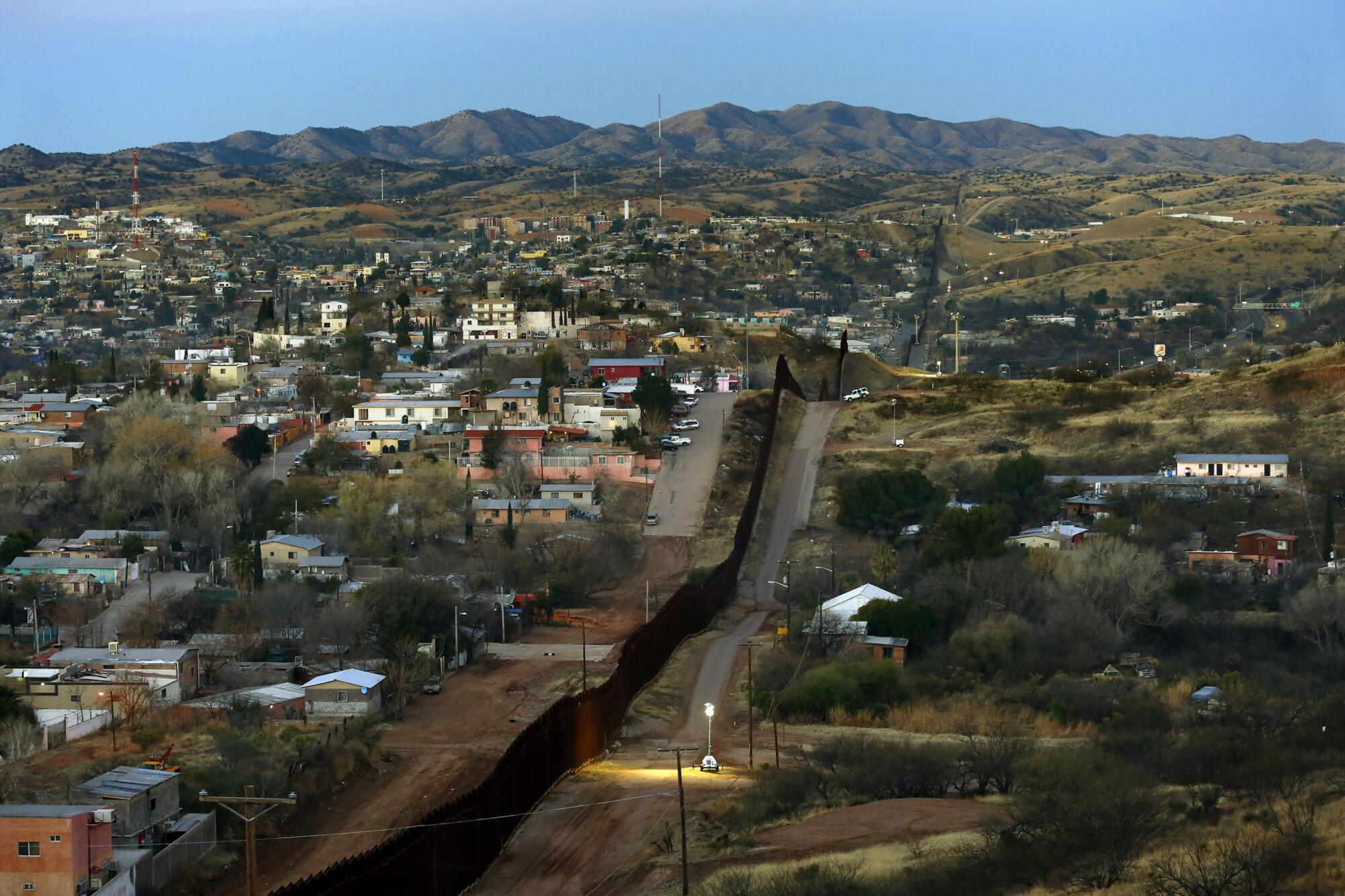
“This is just a small way of fighting back,” he said. “It’s only a drop in a 5-gallon bucket.”
Mac estimated it was his 15th or 16th trip to the border; he’d been coming since around 2014, just before the documentary “Cartel Land” first injected Foley into the national conversation. The film portrays him as the American counterpart to vigilante groups in Mexico that have taken up arms to rid their towns of drug cartel members.
Since then, dozens of media outlets have come calling. When The Times shadowed Foley for part of two days along with a film crew from Scripps News, he also gave interviews to a Dutch documentary crew and two journalists from the Daily Mail. Later that week he called into former Trump advisor Steve Bannon’s talk show.
“We don’t have a border,” Foley told Bannon, who is set to stand trial in 2024 on charges he duped donors who gave money to build a border wall. “We have a revolving door.”
***
Arizona Border Recon has some vocal supporters in Arivaca, chiefly Jim and Sue Chilton, an octogenarian couple whose cattle ranch spans more than 50,000 acres, including a portion along the border where Foley’s group sets up camp.
The Chiltons also put out hidden cameras to capture evidence of migrants crossing their land, and they say they routinely find their barbed-wire fences cut by trespassers. They say they have found more than 30 bodies on their land, people who became lost in the desert, and they put out water troughs in an effort to prevent more deaths.
Like Foley, the Chiltons are also frequent subjects of media attention. Sue keeps a booklet filled with business cards of journalists who have visited their ranch house. The Chiltons make claims of suspected MS-13 members knocking on their door and cartel shootouts overheard in their pastures, painting a picture of perpetual danger and lawlessness that has been beamed and reprinted around the globe.
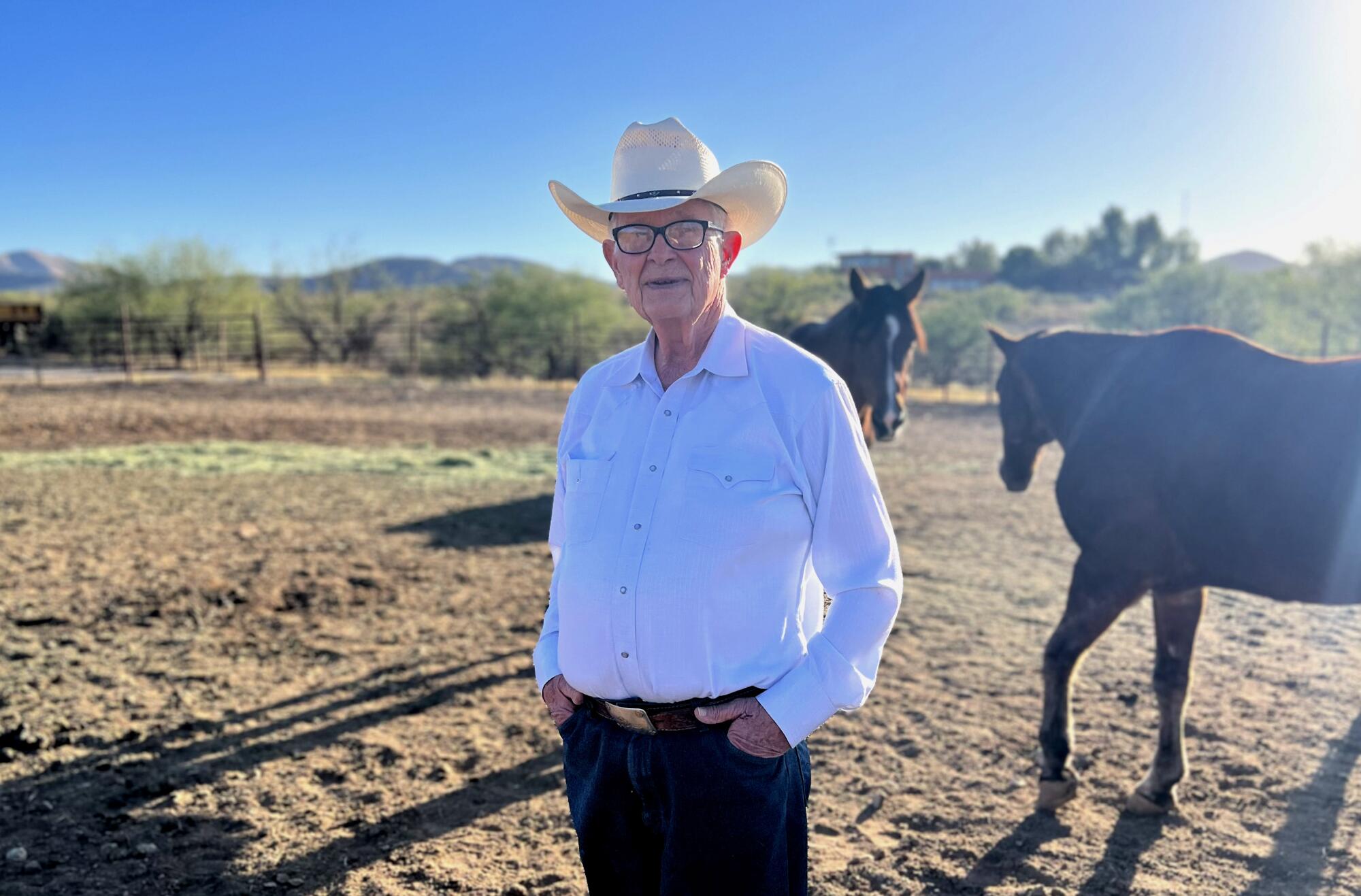
Jim, who turned to ranching after a career of investment banking in California, was invited by Trump to speak at a Farm Bureau Convention in 2019, and he believes the former president’s policies are the best solution at the border.
“We’re a nation of people who want everybody and everything to be legal,” he said. “And we really need to secure the border, which means finishing the wall, putting our Border Patrol at the wall and arresting anybody that tries to come through.”
Sue says Arizona Border Recon is mostly “a first-rate rescue squad,” and the elderly couple feels safer when Foley’s group is camped out on their land.
As Jim put it: “The cartels know they are there and they’re not running people through at least that part of the border.”
Mexican cartels are undoubtedly active in the area. In the Sonoran towns of Sasabe and Altar, there have been reports of gun battles between factions of the Sinaloa cartel fighting for control of migrant smuggling routes, forcing around 100 people to flee their homes. So far, the violence has not spilled across the international boundary, and aid groups in Mexico are coping with the fallout.
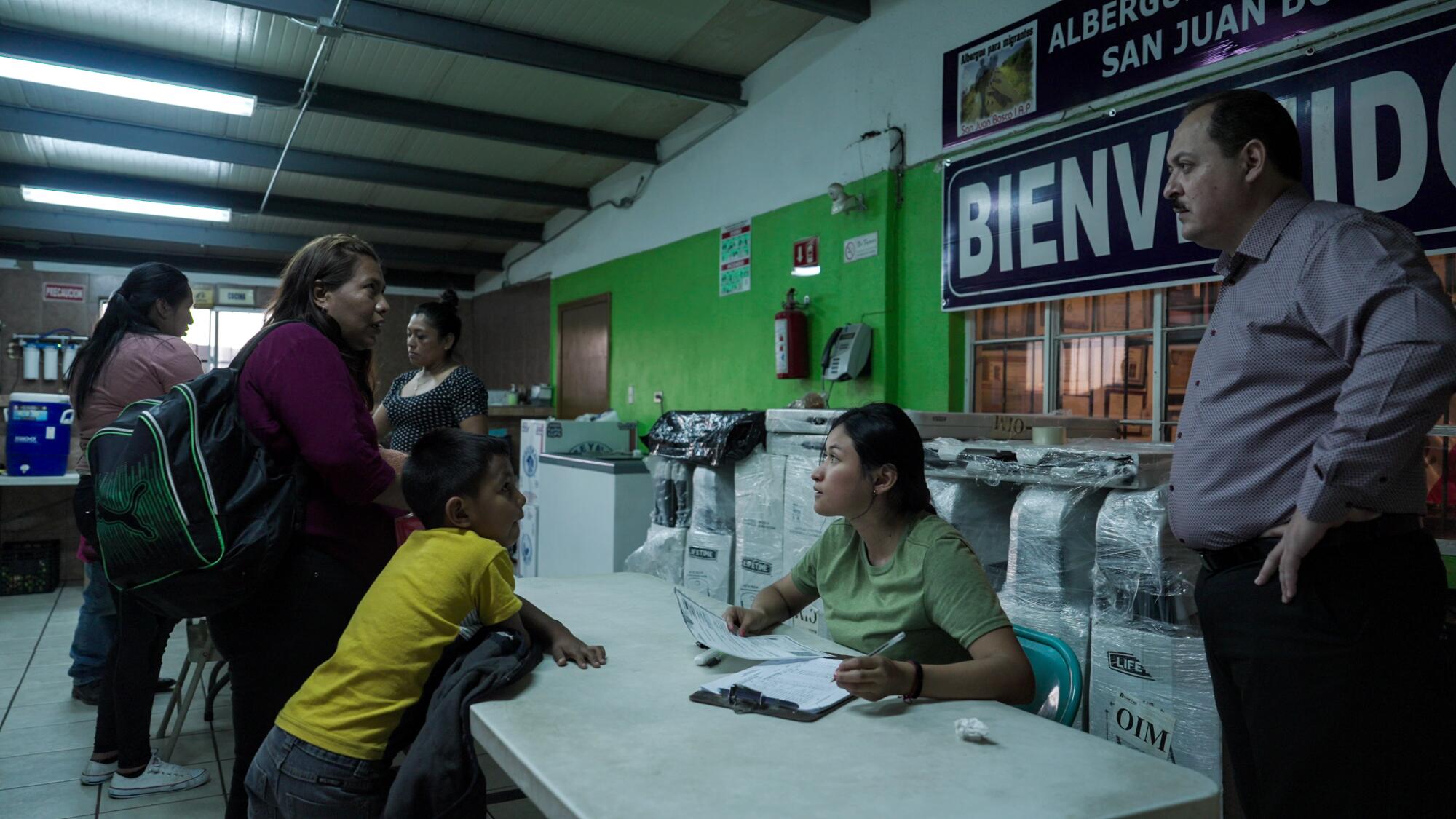
On a recent visit, the San Juan Bosco migrant shelter in Nogales was full of Mexicans from across the country, along with asylum seekers from as far away as Colombia. There were a number of people who said they’d been caught attempting to cross illegally and deported, some less than 24 hours earlier.
Javier Ojeda, 33, from Veracruz, Mexico, said he was trying to return to Southern California and find work as a roofer, as he’d done in previous years to support his wife and three children. He said the money he earned building homes in the U.S. was “10 times better” than what he could make in Mexico. He was sore from the hike across the desert, but he said he planned to try another crossing as soon as his body recovered and he could save up several thousand dollars to pay a coyote to guide him.
“The reality is, not all of us are bad,” he said. “I had the opportunity to be there, and the Americans said I was a good worker. Not everyone is running from something here.”
One coyote in Nogales, who requested anonymity because his business is illegal and he feared retaliation, told The Times he has to pay “a monthly fee” to the cartel that controls his route for permission to operate. The coyote said he charges clients around $8,000 to reach Phoenix and up to $15,000 for Chicago or New York.
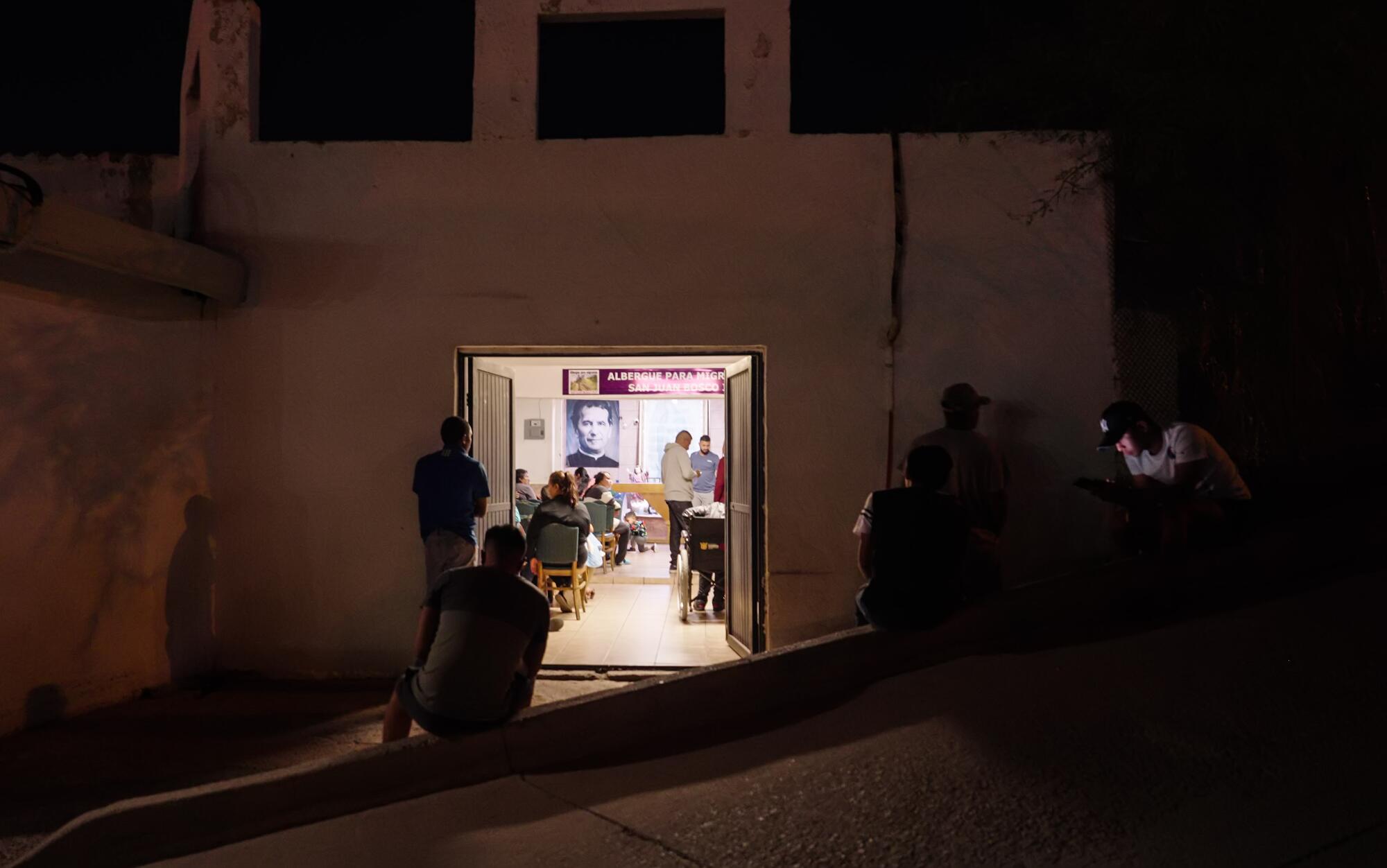
Foley and the Chiltons say many of the camo-clad border crossers are carrying backpacks full of drugs, but federal law enforcement data show the vast majority of fentanyl and other narcotics pass through ports of entry, trafficked by U.S. citizens. Although migrants are still sometimes used as drug mules, the coyote said most people he sneaks across are just planning to work.
He wasn’t familiar with civilian patrols such as Foley’s, but he said if he ever encountered armed people on his route, he would simply wait them out or walk around, out of sight of their lookout points.
“Nothing could put an end to this,” the coyote said. “While there’s poverty and no good jobs here [in Mexico], the people are going to keep coming and going.”
Scripps News producer Jesse Seidman and associate producer Avery Schmitz contributed to this report.
More to Read
Sign up for Essential California
The most important California stories and recommendations in your inbox every morning.
You may occasionally receive promotional content from the Los Angeles Times.















